Written by Audrey Woods
April 2, Day 1 Sessions
The Heart and the Chip: Our Bright Future with Robots
Member Talk: AI’s Critical Role in Keeping Pace with Global Agricultural Demands
Redesigning the Cloud System Stack: An ML-Driven Approach
April 3, Day 2 Sessions
Innovation Out of the Lab: Startups @ CSAIL
Keynote: Physical Intelligence — Achieving Human Level of Manipulation and Locomotion Abilities
CSAIL Alliances Professional Programs
Member Talk: Integrating HOT Capabilities Into LLM
Unleashing Seamless Integration: How Generative AI Builds Bridges in Your Digital Ecosystem
Recruiting Top Talent and Event Opportunities at CSAIL
Future of Data, Trust, and Privacy Panel
EVOLVE: Next Generation Software Efficiency @CSAIL
MachineLearningApplications@CSAIL Panel
April 4, Day 3 Sessions
Member Talk: Assured Autonomy in Defense Applications
Visiting Industry Researcher Program
The Art and Science of Integrating Scientific ML and Physics-Informed AI into Industrial Processes
PAC Privacy: Data Privacy for the Age of AI
Leveraging Alliances Benefits Remotely
The Latest Advances in Generative AI
Robot Revolution—Where Do We Stand
Cybersecurity and Large Language Models
April 2
Welcome & Overview
Daniela Rus: Director, MIT CSAIL & Professor, MIT EECS
- CSAIL is the largest lab at MIT—with about 1500 members, 122 active PIs, and 720 students—and has grown significantly in recent years.
- Unlike other fields, computer science and AI research empowers students to jump right into projects and experiments early on in their education.
- Researchers at CSAIL are tackling important questions like: How should robots represent the world around them? How can we compute on encrypted data? How can we predict the risk of lung cancer? And many more.
- Professor Rus says, “Whatever you’re interested in, we probably have the leading minds in that area.”
Key Quote: “Our mission is to invent the future of computing and make the world better through computing.”
The Heart and the Chip: Our Bright Future with Robots
Daniela Rus: Director, MIT CSAIL & Professor, MIT EECS
- With The Heart and the Chip, Professor Rus endeavored to “write a book that would invite everyone, not just technologists, to dream about a better life with machines.”
- Showcasing that robots can improve a wide array of fields and situations, Professor Rus used an example where she and her team used drones to help a biologist get close to the whales he’d spent his life studying, radically improving his ability to observe and understand the pod.
- She also highlighted robots from her lab that swim like fish, detect shadows to see around corners, help the visually impaired navigate the world, and even make cookies.
- Robots can offload work tasks that are unpleasant, dangerous, or tedious; can augment humans to extend our reach; and can enable new capabilities that have not been possible before.
- However, there are several “to-do” improvements that are necessary to bring about a future of widespread robotics (better hands, softer robots, more intuitive interactions, etc.) and challenges to keep in mind going forward (privacy & trust, energy & climate, disinformation, inequality, etc.).
- Overall, robots are tools that can address many of the real, tangible human challenges of today.
- Key Quote: “Everyone’s lives can be better with machines.”
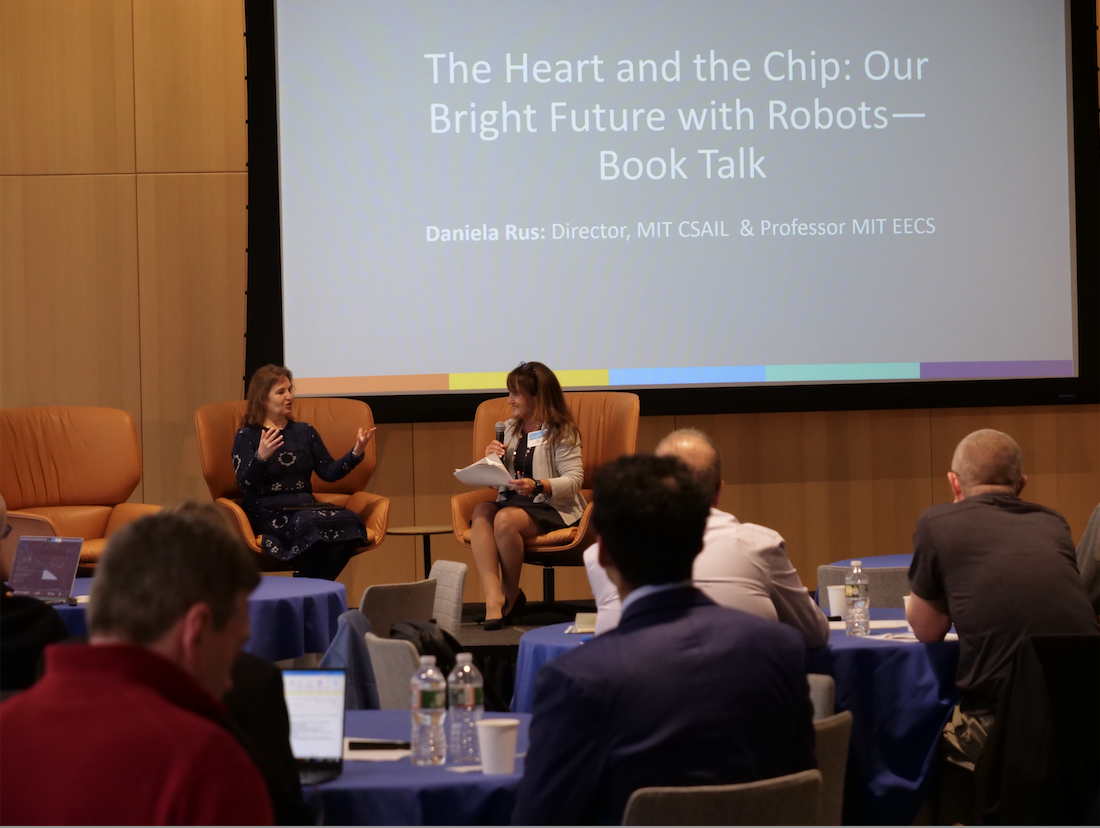
Member Talk: AI’s Critical Role in Keeping Pace with Global Agricultural Demands
Ethan Pickering, AI-Assisted Genetic Design Team Lead, Bayer Crop Science; Senior Lecturer, MIT Mechanical Engineering
- With population growth, climate change, globalization, evolving regulations, and a larger focus on sustainability, the need for dynamic solutions in agriculture has never been more pressing.
- Agricultural data is increasing in scale, resolution, source, and type. Within Bayer’s Crop Science Division, the AI Genomics Research Team is applying AI to make use of this expanding data.
- The team is currently designing capabilities in four AI areas for application in agriculture:
- Bio-informed GNNs that embed biological domain knowledge to better predict phenotype based on genotype.
- Models that can help understand and predict rare disease resistance traits.
- Using Bayesian Optimization and Active Learning to accelerate genomic improvement of crops.
- Leveraging LLMs to pinpoint high value editing targets in genomes to accelerate gene editing discoveries.
- Key Quote: “We’ve come a long way in the last 80 years in agricultural efficiency … we must accelerate that trend, but, critically, do so while improving sustainability, meeting societal standards, and ensuring the livelihoods of those who grow our food.”
Trust & Responsible AI
Arun Ravindran: Chief Data Scientist, BCG X
- The rise of generative AI technologies brings with it an array of risk areas, including “Shadow AI,” or the use of generative AI outside of IT governance and official corporate procedure. This creates the pressing need for programs and strategies designed to mitigate AI-related risks.
- BCG’s definition of Responsible AI (RAI) is: “an approach to deploying AI systems that is aligned with a company's purpose and values while still delivering transformative business impact.”
- BCG recommends holistic approaches that:
- Lay out an agreed-upon set of AI-specific ethical principles.
- Apply appropriate controls end-to-end across product lifecycles.
- Integrate RAI into existing governance and risk management practices.
- Key Quote: “Everyone wants to be responsible, but not everyone knows what that means.”
Trust & Responsible AI
Daniele Quercia: Director of Responsible AI, Nokia Bell Labs Cambridg
- AI is one of the biggest societal changes we are currently experiencing. Despite its enormous promise, we must also prepare for the risks associated with widespread adoption and improvement.
- There are six pillars of Responsible AI:
- Fairness
- Reliability
- Privacy
- Transparency
- Sustainability
- Accountability
- Responsible AI can be prioritized in the design stage, during deployment, and while actively running through regular monitoring.
- AIDesign is a tool that eliminates the need for lengthy checklists and, using a 22-point list of guidelines, can help designers think about accuracy, fairness, and transparency in the design stage and anticipate potential blind spots.
- RiskGen rapidly brainstorms an array of potential uses and risks during the deployment of an AI program to identify where it might not comply with legal standards.
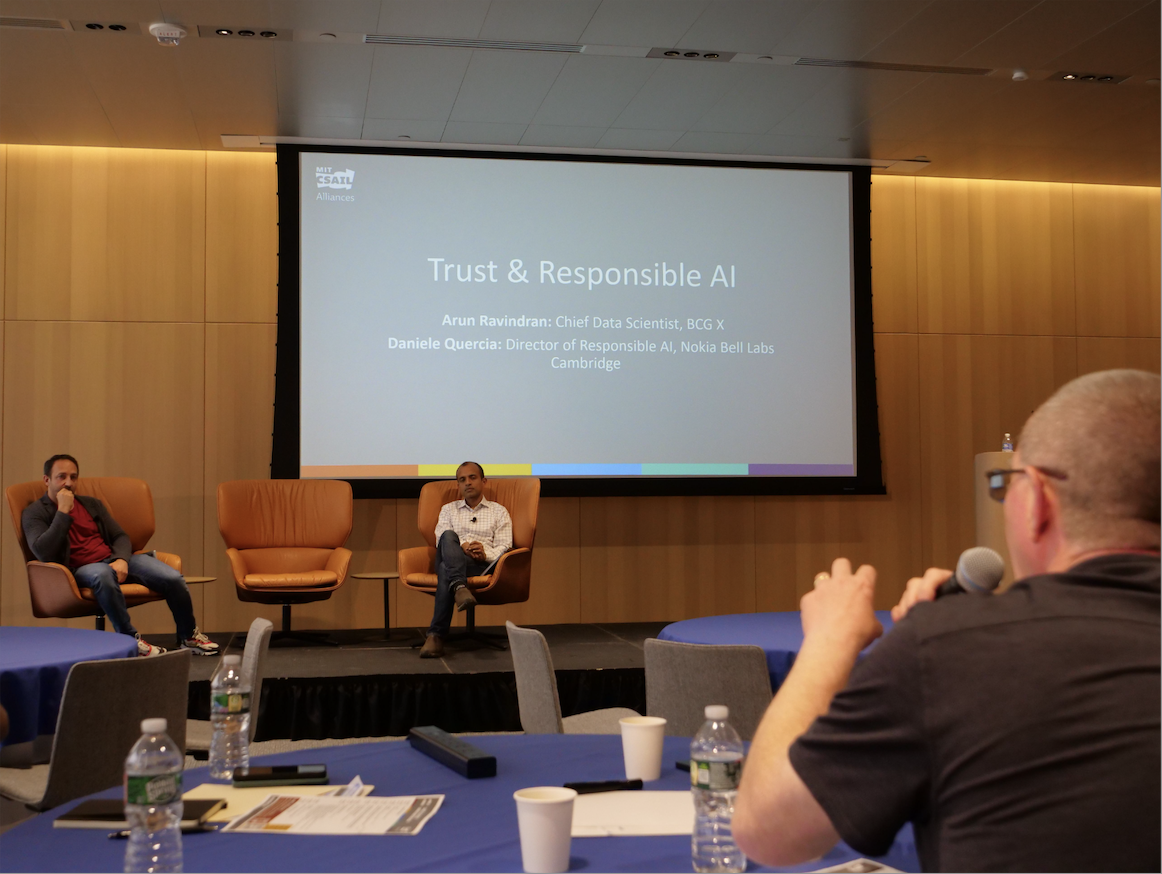
Redesigning the Cloud System Stack: An ML-Driven Approach
Christina Delimitrou, Assistant Professor, MIT EECS, CSAIL
- The demands of hardware and software in cloud computing have both exploded in complexity.
- One aspect of this is the transition from monolith services to microservices, which offer modularity, specialization, and faster development, but come with the challenge of performance unpredictability and cascading QoS violations.
- Seer & Sage (datacenter software programs) can help tackle QoS challenges through ML-driven performance debugging and cluster management.
- Seer requires supervised learning and detailed instrumentation to achieve high accuracy.
- Sage can apply unsupervised learning and requires less detailed instrumentation to offer more practical performance debugging at scale.
- In practice, Seer & Sage can diagnose the majority of QoS violations, provide insight on how to better design and deploy complex microservices, and offer higher performance predictability and resource efficiency.
- Key Quote: “We have to rethink what the cloud systems actually look like… ML is one very promising way of doing that.”

Book Talk: MIT Authors Panel
Future Ready: The Four Pathways to Capturing Digital Value
Stephanie Woerner: Principal Research Scientist, MIT Sloan School of Management; Executive Director, CISR
- Digital innovation is driving two distinct and necessary transformations:
- The expectation of operational excellence supported by automation technologies, process simplification, and reuse.
- Customer-focused opportunities that empower users to experiment with and release digital offerings.
- Only 26% of businesses are “future ready,” meaning they have great customer experience, are modular and agile, have dynamic partnering, use their data as a strategic asset, and simultaneously innovate and reduce costs.
- The four pathways to being “future ready” are:
- Through industrialization, which initially relies on heavy back-end work to digitize all systems and processes.
- Making a big leap by integrating customer experience across the board.
- Using stair steps, making small, incremental gains in both operational excellence and customer experience in the direction of being future ready.
- Creating an entirely new future ready business unit or organization.
The Magic Conveyer Belt: Supply Chains, AI & The Future of Work
Yossi Sheffi: Elisha Gray II Professor, Engineering Systems; Professor, MIT Civil and Environmental Engineering; Director, MIT Center for Transportation & Logistics
- Supply chains are rapidly automating due to warehouse robotics, autonomous vehicles, autonomous stores, machine translation, etc.
- Technology leads to deskilling, lowering the barrier of entry to various tasks.
- Generative AI is in the processing deskilling creativity.
- Some jobs get eliminated (elevator operators, telegram messengers, etc.) but others are created as the economy changes.
- Previous predictions have vastly overestimated how quickly technology will eliminate jobs.
- Job transformation is also a slow process, hindered by public acceptance, regulations, and labor unions.
- Key Quote: “Scaling is doing more with less.”
Disciplined Entrepreneurship: 24 Steps to a Successful Startup
Bill Aulet: Ethernet Inventors Professor of the Practice at the MIT Sloan School of Management; Managing Director, Martin Trust Center for MIT Entrepreneurship
- Innovation requires invention * commercialization (i.e., you need both and if either is zero, you get no innovation). Right now, society overvalues invention while undervaluing commercialization, leading to a “broken” pipeline of bringing research to market.
- Entrepreneurship is a craft that can be taught but hasn’t been taken seriously as such.
- To fill this gap in entrepreneur education, professional educators at MIT developed an open-sourced and evidence-based approach to guide future entrepreneurship training and education.
- A 10-year longitudinal study shows that the methodology is successful with various important markers like high student satisfaction, a high startup survival rate, validation of companies by professional funders, good sustainability metrics, etc.
- · The framework offers a 24-step guide, structured in six themes:
- Who is your customer?
- What can you do for your customer?
- How does your customer acquire your product?
- How do you make money off your product?
- How do you design & build your product?
- How do you scale your business?
- Key Quote: “Entrepreneurship is not just about startups, and thinking so is limiting your company.”
April 3
Innovation Out of the Lab: Startups @ CSAIL
Christiana Kalfas: Client Relations Coordinator, CSAIL Alliances
- Since last year, more than 50 CSAIL Startups have joined Startup Connect, and the Startup Connect Plus program (created for startups not spun out of CSAIL research) has more than doubled.
- Startup Connect and Startup Connect Plus now work cohesively with groups across MIT campus—such as VMS and I-Corps—sharing benefits, collaborating on events, and bringing more resources to the MIT startup ecosystem, with programming now built into membership.
- These programs have global presence, with startups based around the world.
- Members have the benefit of getting a “front seat” to this innovation, through research, community interaction, events, and custom content such as our Research to Reality series & Case Studies.
- Key Quote: “Being a member of CSAIL Alliances means getting a front row seat to startups as they’re spinning out and eager to connect with larger companies.”
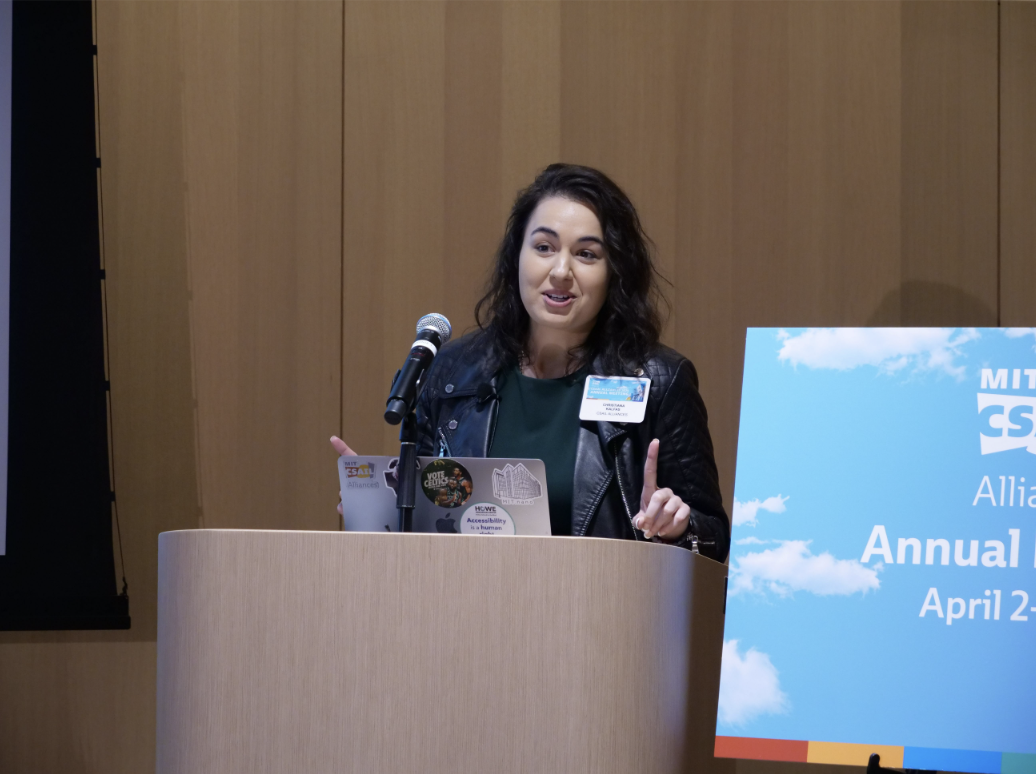
Keynote: Physical Intelligence — Achieving Human Level of Manipulation and Locomotion Abilities
Pulkit Agarwal: Assistant Professor, MIT EECS, CSAIL
- If you are interested in further learning about AI and Robotics -- Prof. Agrawal is leading a three-day course offered by MIT Professional Education (https://professional.mit.edu/course-catalog/ai-robotics-learning-algorithms-design-and-safetythat will go in-depth into emerging trends in the space.
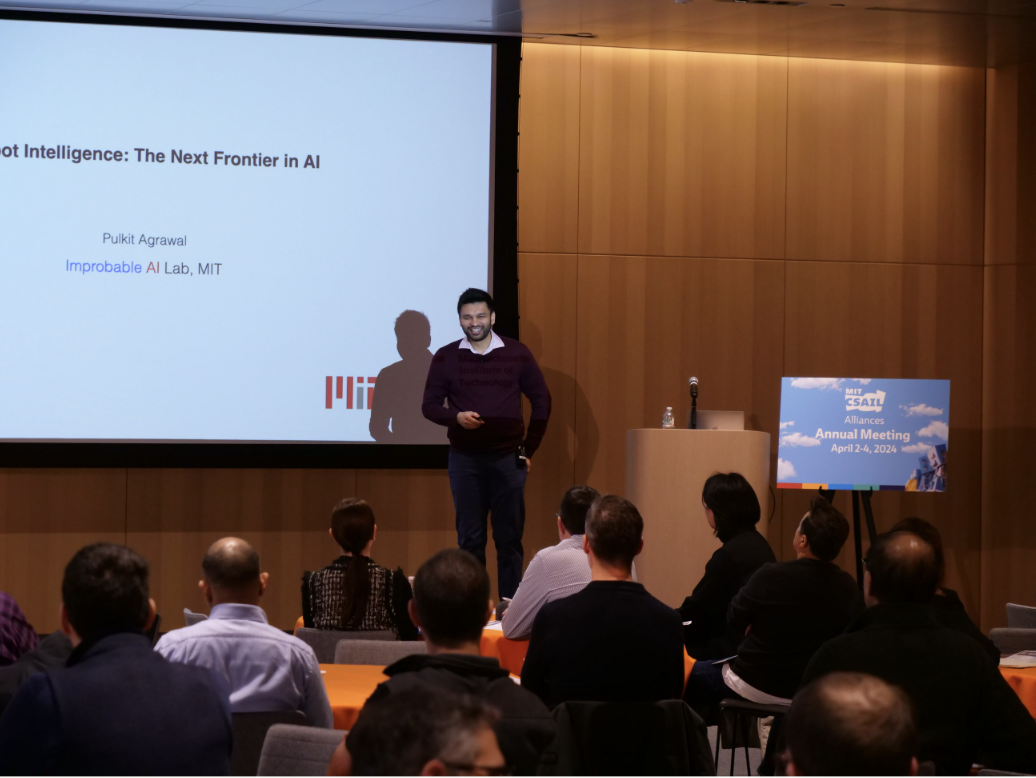
CSAIL Alliances Professional Programs
Callie Mathews, Professional Programs & Partnerships Manager
- CSAIL Alliances creates online and in-person professional workshops and programs that provide technical understanding of the latest advances with a focus on how those technologies can be used in business.
- Our online certificate programs are 6-8 weeks of self-paced learning that culminate in an MIT Certificate of Completion. Our current programs are:
- Artificial Intelligence for Business Implications
- Machine Learning for Business
- Human Computer Interaction for User Experience Design
- A Cybersecurity Post Graduate Program
- SNAPSHOTs are in-person or virtual small group discussions on a topic of the member’s choice, led by a world-renowned MIT expert.
- Custom programs are also available for deeper learning & engagement, to gain specific insights from CSAIL faculty or to meet a particular education goal.
- Further benefits are available to assist with talent development, enrichment, and advancement through your CSAIL Alliances membership. Benefits include lab visits, discounts on other CSAIL and MIT programs and events, research talks and recordings, and the resources available on the CSAIL Alliances Website.
Member Talk: Integrating HOT Capabilities Into LLM
Dagnachew Birru: Head of R&D, Quantiphi
Muneeswaran I: Sr. Machine Learning Engineer, Applied Research, Quantiphi
- Beyond content generation, LLMs can be utilized in coding applications to optimize prompts and code, in physical systems interfacing with simulations and robotics, in conversation, and more.
- Higher Order Thinking (HOT) means LLMs that can apply, analyze, evaluate, and create. HOT gives LLMs the ability to solve much larger and more complex problems.
- HOT capabilities are advantageous across various domains, such as:
- Analyzing and summarizing medical literature.
- Accident claims processing.
- Creating marketing content.
- Analyzing customer sentiment and feedback.
- Qnowledge Engineer is a system which accelerates the process of building prototypes by breaking down an abstract idea (for example: creating a customer feedback summarization system) into an executable workflow of “skills” and then leveraging LLMs to rapidly provide usable outputs.
- In the future, such "skills" might be integrated with digital and physical systems to provide further automation abilities.
- Key Quote: “Previously, HOT was applied by educators, delineating the different levels of thinking and skills. The application of HOT to LLMs opens new avenues of the development of novel capabilities.”
Unleashing Seamless Integration: How Generative AI Builds Bridges in Your Digital Ecosystem
Vikram Aryan: Global Technology Head, Linedata
Gary Brackenridge: Global Head Strategy, Linedata
- Big companies can have 10s or even 100s of disparate applications, technologies, models, and vendors, which present enormous communication and logistical challenges.
- AI can help integrate digital ecosystems via:
- Updating legacy APIs to modern APIs.
- Automatically build integration code using application APIs.
- Using LLMs to make use of valuable data.
- Using AI conversion tools in large cloud databases.
- Current challenges in AI solutions are contextualization, hallucinations, and key limitations in deployment such as privacy, complexity, and obsolescence.
- Going forward, the best case scenario would be the introduction of API standards, documentation standards, auto testing, and eventually private LLMs with case-specific contextualization.
- However, realistically, businesses should embrace heterogeneity, combinations of content-aware models, existing embedded logic, and auto integration code.
- Key Quote: “Solving the integration problem in a never-ending heterogenous world, that’s the dream.”

Recruiting Top Talent and Event Opportunities at CSAIL
Philip Arsenault: Client Relations Manager, MIT CSAIL Alliances
Matthew Busekroos: Operations Coordinator, MIT CSAIL Alliances
- Through CSAIL Alliances, you can engage students by:
- Posting jobs & internships.
- Using the Student Profile Book to explore student talent.
- Attending student poster sessions.
- Following the student spotlights on our website.
- Supporting student startups.
- Funding sponsored research.
- Hosting a technical talk.
- Coming to regular events like Byte Bites.
- Supporting programs like MEnTorEd Opportunities in Research (METEOR), Summer Geometry Institute, and Graduate Women in Course 6.
- And more!
- There’s lots of talent at MIT CSAIL, and CSAIL Alliances is a good way to access and leverage it.
Future of Data, Trust, and Privacy Panel
Srini Devadas: Faculty Co-Director, MIT Future of Data, Trust, and Privacy; Professor, MIT EECS, CSAIL
Taylor Reynolds: Technology Policy Director, MIT Internet Policy Research Initiative
Nirmal Baid: Vice President, Strategic Data and AI Initiatives, Visa
Awah Teh: VP, Data Governance & Privacy Engineering, Capital One
Kevin Fitzpatrick: Head of Privacy, Data, and AI/ML Governance, MassMutual
Figen Ceceli: SVP, Head of Data Aggregation Product, Fidelity Investments
- Data is more useful if it can be shared, used, and computed upon. In financial institutions (and other applications) secure sharing, transparency, purpose limitations, and privacy of data are necessary considerations to empower consumers and build and preserve trust.
- Evolving regulations and standards also make it challenging to anticipate how requirements might change and design robust systems that will continue to meet these standards.
- As members of the MIT Future of Data (FOD) Research Initiative, Fidelity Investments, MassMutual, Capital One, and Visa are working toward protocols and technical solutions that prioritize ongoing user consent, data security, privacy, and transparency. Collaborating with research institutions like MIT accelerates innovations in this space.
- Some of the recent ideas being explored through FOD include:
- Applying traceability measures in data sharing.
- Augmenting open banking protocols for transparency of consumer consented data use.
- Automating data privacy preservation in ML pipelines.
- Improving private data retrieval, collection, and analysis.
- Using synthetic data for privacy-preserving analytics.
- And more!
- Fundamentally, these projects aim to match technology to policy.
- Key Quote: "It's a golden era in privacy technology." ~ Prof. Srini Devadas

EVOLVE: Next Generation Software Efficiency @CSAIL
Lori Glover, Managing Director of CSAIL Alliances
Adam Belay: Associate Professor, MIT EECS, CSAIL
Charles Leiserson: Professor, MIT EECS, CSAIL
- In order to keep up with the increasing demand for computing resources—especially ML, AI, and data processing/storage—energy-efficient approaches are necessary to mitigate environmental and financial costs.
- The new CSAIL initiative EVOLVE will focus on research developing efficient algorithms, optimizing system network and architecture for performance, and creating methods to measure and assess performance and efficiency. The initiative will be co-directed by Professor Charles Leiserson and Assistant Professor Adam Belay.
- Professor Belay’s research focuses on improving efficiency at data centers, which are stressed due to the “insatiable demand” of AI. Some of the opportunities for efficiency that Professor Belay is looking into are:
- Idle resources and better resource management.
- Speeding up common building blocks in computing cycles.
- Bypassing kernels, which lead to high OS overhead.
- Professor Leiserson’s research focuses on enabling programmers to design more efficient software through faster code. Some of his ongoing work in this area is:
- OpenCilk, an open-source platform that makes parallel programming a simple extension of serial programming.
- Speedcode.org, a prototype collaborative, open-source, online programming platform for learning how to write fast code.
- His software performance engineering course to help students think about writing fast code.
- Contact CSAIL Alliances Associate Director Glenn Wong (glennw@mit.edu) to get involved.
- Key Quote: “We’re looking forward to the opportunity to get problems from companies and contribute our expertise to solving real problems.” ~ Prof. Charles Leiserson
MachineLearningApplications@CSAIL Panel
Daniela Rus: Director, MIT CSAIL & Professor, MIT EECS
Ali Payani: Head of Responsible AI Research, Cisco Research
Vishal Gossain: Partner, Practice Leader, Risk Analytics and Balance Sheet Management, EY
Nathan Eden: Research and Network Strategy, BT
- MLA@CSAIL—supported by BT, Cisco, and EY—is an initiative focused on creating ML applications for impact and addressing current challenges in ML technology. This year, MLA is focused on: privacy and security using AI, AI quality control, productivity in both AI and the workforce, and advancing innovative ML methodologies.
- Being a part of the initiative offers benefits such as up-to-date information about the latest advances in ML, engaging with and recruiting top talent, interaction with other founding members, and maximum exposure to pioneering ideas with limited time available.
- Going forward, MLA@CSAIL will be broken into three themes:
- Learning Robots—creating machines that can automatically and continuously learn about their environment.
- Programmable Therapeutics—improving the understanding and treatment of diseases by applying ML to genomics, therapeutics, and drug design.
- Visual Computing—creating machines that can “see” by revolutionizing visual computing systems.
- Looking forward, the initiative members hope to find ML solutions for challenges like optimizing LLMs, reducing hallucinations, supply chain optimization, sustainability concerns, democratized accessibility, and more robust cybersecurity.
- Key Quote: “There is no area today that is more impactful than machine learning and, in particular, ML in business.” ~ Professor Rus
April 4
DAF-MIT AI Accelerator
Charles E. Leiserson: Professor, MIT EECS, CSAIL
- With the widespread proliferation of AI technology around the world, it’s important for the US to have a competitive advantage in understanding and using AI for defense. The DAF-MIT AI Accelerator was created to prioritize AI education, innovation, and bringing AI technology from research to implementation.
- Comprised of three entities—MIT campus, MIT Lincoln Lab, and the DAF—the DAF-AI Accelerator brings together over 150 faculty, students, and researchers, embedding airmen and guardians directly into MIT research groups to create an innovation ecosystem around AI.
- Some projects that have led to real-world impact include:
- Neural models for magnetic navigation.
- AI optimization of training schedules.
- Air guardian autonomy.
- Conversational AI.
- Utilizing a highly collaborative and integrated approach, the program acts as a state-of-the-art, end-to-end, sustainable pipeline for AI technology.
- Key Quote: “The success we’re having in this program is unprecedented.”
Member Talk: Assured Autonomy in Defense Applications
Guy Swope: Raytheon Senior Technology Staff
- Definition of Autonomy: “The intersection of purpose-built artificial intelligence (computer software) that transforms data sensed in the environment into purposeful plans and then performs actions to accomplish a mission objective/task.”
- There’s a spectrum of autonomy with varying levels of machine-to-human interaction (controlled to empowered) and inter-machine interaction (independent to collaborative).
- Swope introduced two examples in the air domain:
- Collaborative Combat Aircraft (CCA), where a pilot operator directs a group of “little buddies,” or autonomous wingmen.
- Networked Collaborative Autonomy (NCA), or a weapons system that uses AI, ML, and networked communication to increase survivability and lethality, always with a human in the loop.
- There are major assurance challenges to consider when applying autonomy to defense including a lack of transparency, brittleness in the AI programs, exploitation by adversaries, DoD standards, testing variability, and general public trust.
- Some of these can be addressed with solutions like more transparent AI technologies, selective ML behaviors, constraining autonomy to “outer loop” parameters like mission planning and strategy, and keeping a human in the loop.
- However, research is still needed in: explainable AI, ethical AI, adversarial AI, counter autonomy, human-machine interfaces, and autonomous system testing.
- Key Quote: “There’s still research that needs to be done to make these systems more effective and more trustworthy."

Visiting Industry Researcher Program
Glenn Wong: Associate Director, Business Development and Client Relations, MIT CSAIL Alliances
- The Visiting Industry Researcher (VIR) Program is a CSAIL Alliances benefit that enables industry researchers to spend 6-12 months working side-by-side with MIT CSAIL faculty and students.
- A VIR benefits members through:
- Research: getting CSAIL expert insight on an industry problem and/or working on big impact projects alongside CSAIL scientists.
- Personal Development: employees sent to research at CSAIL have access to unique opportunities in academia (publishing, conferences, etc.) and develop skills and techniques that might be useful for their companies at home.
- MIT + CSAIL Community: visiting researchers become a part of the vibrant CSAIL and greater MIT community, and also act as their company’s ambassador at MIT.
- VIR benefits CSAIL through:
- Industry Perspective: CSAIL researchers get to learn about, work on, and help address real-world problems.
- Useful Work Done: visiting scientists contribute to research endeavors and move forward the innovative projects happening at CSAIL.
- Strengthen Relationship with Members: reinforcing the bridge between a given company and CSAIL Alliances helps both parties get the most value out of the relationship.
- Learn more about the VIR program on our website or contact your Client Relations Coordinator (CRC) to find out how to apply.
The Art and Science of Integrating Scientific ML and Physics-Informed AI into Industrial Processes
Alan Edelman: Professor, MIT Mathematics, CSAIL
Chris Rackauckas: Research Affiliate, MIT CSAIL
- Traditional wisdom in programming says that a programming language can be either easy to use or fast but not both. With Julia, researchers set out to prove this wrong, creating a general-purpose, high-performance programming language.
- The Julia Lab at MIT blends computer science and computational science to accelerate computation using Julia, with a focus on the theoretical and numerical aspects of the core language. Many startups have also been created with Julia as their foundation.
- Julia empowers scientific machine learning, which combines real-world physical equations and ML to further scientific discovery and knowledge. Scientific machine learning is offering improvements in a variety of areas such as:
- Individualized drug dosing.
- Real-time racecar trajectories.
- Higher efficiency in crash testing machines.
- And more!
- Julia makes it simple to incorporate scientific models and physical processes with ML to achieve results with less data.
- Key Quote: “If you want the up and coming language, grab Julia.” ~ Professor Edelman
ROI of CSAIL Alliances
Lori Glover: Managing Director, MIT CSAIL Alliances
- Business and academia are natural allies. Without the bridge between them, innovative research ideas “die on the vine,” never reaching the market where they can improve lives and change the world.
- When considering the ROI of the CSAIL Alliances program, it’s important to keep in mind:
- The tangible benefits, such as course discounts and codes, new employees hired, research that contributes to product enhancements, a seat at the table to make decisions, etc.
- The intangible benefits, such as employee learning, brand visibility, exposure to new ideas, connections to experts, networking with other aligned companies, influence on the direction of future research, etc.
- Common reasons for partnership include:
- The advanced thinking and deep understanding of a given topic available at MIT.
- The talent of the students, faculty, and researchers.
- Connection to the ecosystem of technology startups.
- Access to cutting-edge research for a competitive edge.
- Inspiration about directions to innovate and new ways of thinking.
- The benefit of being aligned with a top research institution like CSAIL
- CSAIL Alliances aims to move away from silos and bring collaborative value to companies while at the same time bolster the groundbreaking research happening in the lab.
- Key Quote: “Seeing these nascent technologies just starting, you can see the possibility of where they might go.”
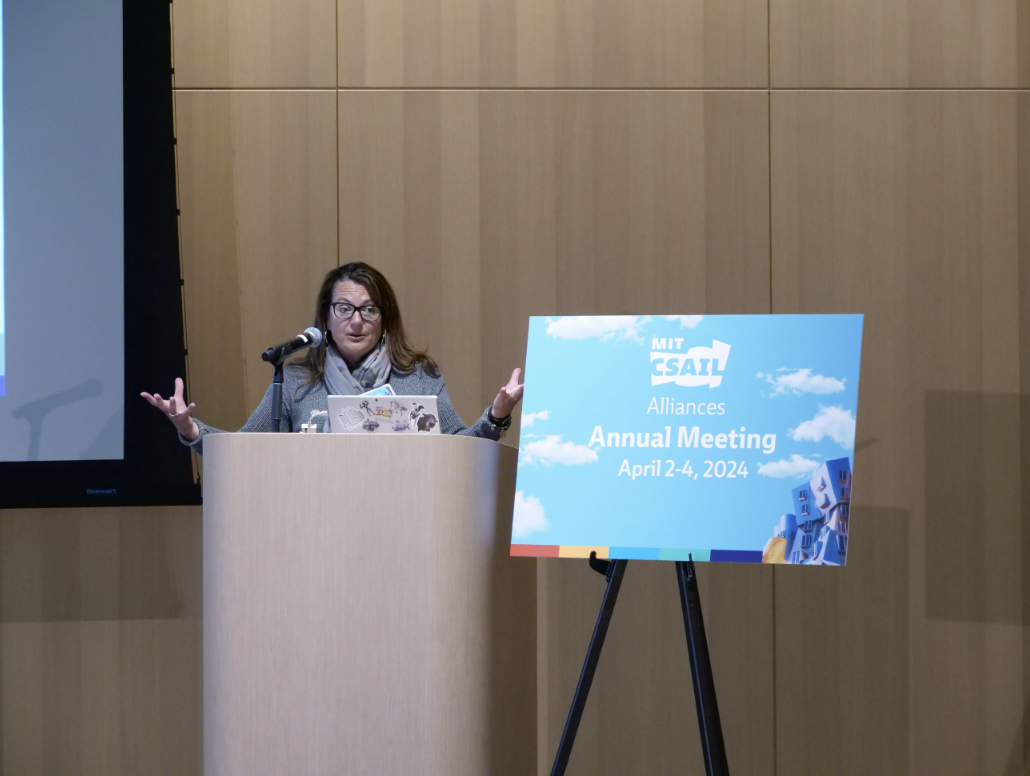
PAC Privacy: Data Privacy for the Age of AI
Srini Devadas: Faculty Co-Director, MIT Future of Data, Trust, and Privacy; Professor, MIT EECS, CSAIL
- Two high-level problems in privacy research are:
- Modeling leakage to quantify how much an adversary can learn about protected data.
- Determining the minimal utility and efficiency overhead to achieve the required privacy for that data.
- Differential privacy offers the ability to protect a sensitive feature or data point but comes with challenges such as performance decline and utility loss.
- Probably Approximately Correct (PAC) Privacy exploits data entropy to give better privacy measurements with improved computational accuracy.
- The idea behind PAC privacy is that if the exposed output (e.g., average salary) is independent of the particular selection of individual salaries, then you can immediately argue that there is individual privacy. If the exposed output has some dependence on the selection, then PAC privacy tells you how much noise to add to obtain individual privacy.
- Using regularization in data preprocessing can stabilize the logistical regression such that less noise is needed to guarantee privacy.
- Future work in this area includes an open-source PAC private database, PAC private LLMs, and using these ideas to think about theoretical, philosophical, and societal problems.
- Key Quote: “Privacy and generalizability are not incompatible.”
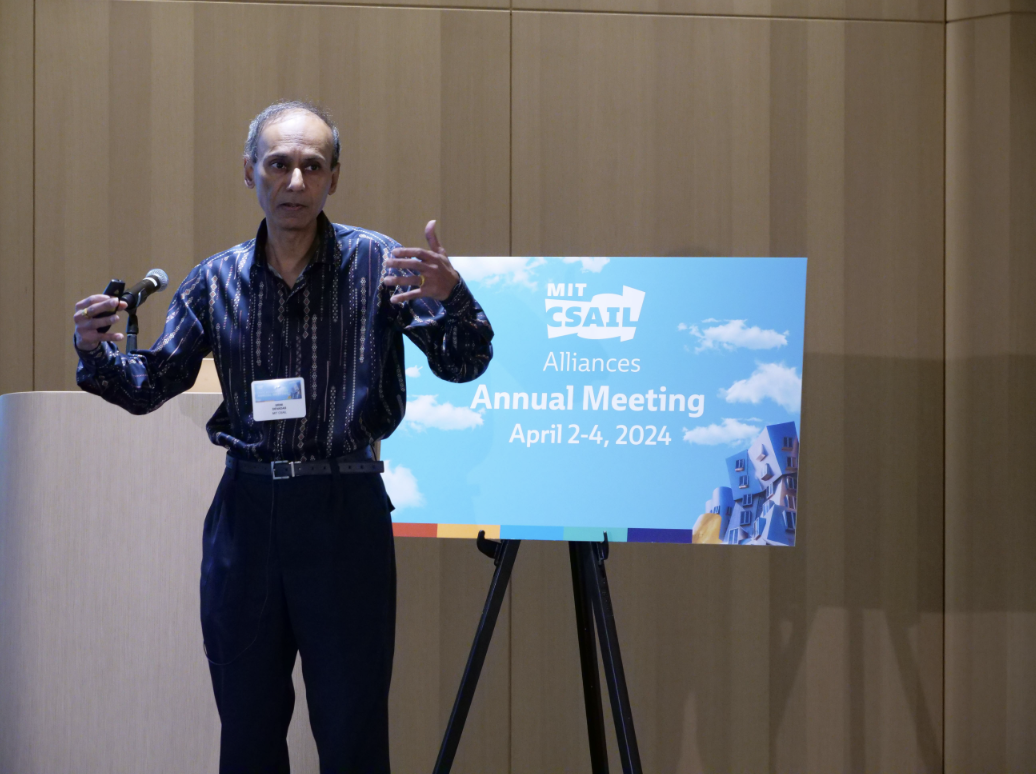
Leveraging Alliances Benefits Remotely
Jessica Gibson: Assistant Director, Marketing and Communications, MIT CSAIL Alliances
Audrey Woods: Digital Presence Content Writer, MIT CSAIL Alliances
Julia Pallis: Digital Content Coordinator, MIT CSAIL Alliances
- The best way to stay engaged with CSAIL Alliances online resources is to subscribe to our bi-monthly newsletter, which includes events, new custom content, news, courses, and discounts.
- All members can create an account on our website, which gives access to exclusive member-only content, such as our Startup Ecosystem Guide, Open Source Projects database, job postings, and more.
- CSAIL Alliances Custom Content includes:
- PI Spotlights—focusing on one CSAIL PI to highlight their background, research, current interests, and thoughts about the status of their field.
- CSAIL Alliances Podcast—a conversation between one or several CSAIL PIs and Boston Globe Correspondent Kara Miller about a hot topic in computing.
- Student & Researcher Spotlights—featuring CSAIL talent, innovative methodologies, real-world applications of current research, and the diversity in the CSAIL community.
- Research to Reality Video Series—showcasing how ideas born in CSAIL have been spun out into market applications.
- Virtual Lab Tours—providing a current glimpse into CSAIL labs, introducing key researchers and illustrating the impact and relevance of various research groups.
- Member Case Studies—offering ideas and guidance on how to leverage CSAIL Alliances for maximum benefit through the example of previous use case scenarios.
The Latest Advances in Generative AI
Jacob Andreas: Associate Professor, MIT EECS, CSAIL
Armando Solar-Lezama: Professor, MIT EECS; Associate Director and COO, CSAIL
Ge Yang: Postdoctoral Associate, MIT CSAIL
- Generative AI has made enormous strides recently and is rapidly changing as a field. However, there are major challenges still to be addressed such as:
- Explainability—understanding what a model is doing on the inside or why it is making a given decision to improve accuracy and safety.
- Truthfulness—creating models that adhere to the world and don’t hallucinate or make mistakes.
- Personalization—getting a model to fulfill requests accurately and aligning models with human values.
- One way to better understand LLMs is by testing their capacity with code. Since code can be mechanically checked and has a clear ground truths, it offers a way to see how accurate LLMs are, where they fail, and how they can be better designed going forward.
- Automating interpretation, or using models to explain models, could be a solution to explainability challenges. It is possible to get natural language descriptions of what a given node is doing and therefore understand what it thinks is true, anticipate errors, and improve our high-level understanding of how models actually work.
- New video generative models such as OpenAI’s Sora are surprisingly good at understanding 3D geometry without people programming in those capabilities manually.
- Video generation offers a promising way to create life-like 3D environments for robots to interact with and learn. Combined with deep reinforcement learning, simulated training in generated environments could change what’s possible in robot agility, and give robots the ability to see.
- Key Quote: “We’ve all had the experience of being very surprised over the past 2 years.” ~ Professor Solar-Lezama
Robot Revolution—Where Do We Stand
Russ Tedrake: Professor, MIT EECS, Aero/Astro, MechE, CSAIL
Brian Williams: Professor, Aero/Astro, CSAIL
John Leonard: Professor, Mechanical and Ocean Engineering; Associate Department Head for Research, MIT Mechanical Engineering, CSAIL
- Large Language Models have been transformative in generative AI. Roboticists are now working on Large Behavior Models, which could have equally enormous implications in the field of robotics.
- Predicting actions is fundamentally different than predicting language because actions are continuous, must obey physics, have stochasticity, and include immediate feedback in terms of stability and accuracy. Also, unlike with images and language, there are limited data sources for physical actions. However, it appears these challenges can be overcome through methods like imitation and simulation learning.
- The field of robotics is very aligned in the pursuit of large behavior models, with high optimism for their potential.
- There is also widespread enthusiasm for multi-agent robot systems, with applications like collision avoidance, path planning, simultaneous operation, and human-robot coordination. A major challenge in that research is designing robots that can plan ahead and anticipate changes in dynamic environments.
- To enable networks of vehicles to navigate together, object-based mapping for situations with high ambiguity will be important. In other words, as Professor Leonard put it, a “Google for the physical world.”
- Professor Tedrake shared this video on teaching robots new behaviors: https://www.youtube.com/watch?v=w-CGSQAO5-Q
- Find Professor Tedrake’s Robotic Manipulation course notes here: https://manipulation.mit.edu
- Key Quote: “Now we have all kinds of tasks that we’ve never been able to do with robots that we can do reliably.” ~ Professor Tedrake

Cybersecurity and Large Language Models
Stephen Moskal: Postdoctoral Researcher, MIT CSAIL
Erik Hemberg: Research Scientist, MIT CSAIL
- In the cycle of the cyber arms race, public LLMs such as GPT4 can elevate the skill level of novice hackers and turn “script kiddies” into more competent cyber adversaries. This process also can be automated to conduct cyber campaigns.
- LLMs can be applied for cyber defense as well, although there are challenges such as a lack of well-defined assessments and knowledge of threat behaviors (it is easier to attack than to anticipate and defend against all potential attacks).
- When using LLMs for defense, it’s important to be aware of specific model biases such as positional bias, where the model’s ability to pick the correct answer out of a given list deteriorates as the list gets longer.
- One promising use of LLMs in cybersecurity is through “honey pots,” or using a generative model to create content such that a would-be hacker believes that they’ve broken into a system but is actually interacting with an LLM producing convincing but non-valuable data. In other words, using LLM hallucination to the advantage of cyber defense.
- Key Quote: “We want to be able to understand what events we see on the offensive side and attribute them to a particular actor so we can then launch countermeasures.” ~ Dr. Moskal
